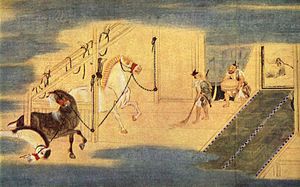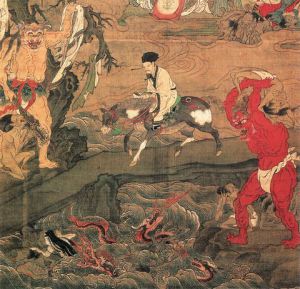Art of Japan and Power Dynamics: Tosa School, Buddhism, and Richness of Culture
Lee Jay Walker
Modern Tokyo Times

One of the most famous schools of art in Japan applies to the Tosa school because of areas related to traditional art and the past longevity of this esteemed school. This exemplary art school flowed naturally before the Edo period and remained until the later stages of the nineteenth century. Indeed, the imperial court looked favorably on Tosa artists based on the alignment of high culture and the traditions they were bestowed with.
Tosa artists evolved internally through the bloodline. At the same time, adopted artists were accepted within the clan of this amazing school or art. Another famous family of art applies to the Kano family. Therefore, these two families in the pre-Edo period and during the Edo era (1603-1867) provided a wealth of cultural art that continues to bless Japan in modern times.

The Meiji Restoration of 1868 would alter the artistic world of old Japan. This equally applies to ending the predominance of ukiyo-e, despite many amazing Meiji ukiyo-e artists that preserved this art form despite the onset of modernity.
In a past article, I state, “Tosa Mitsunobu (1434-1525) is regarded to be the real founder of the Tosa school of art. This is based on the strong connection that occurred with the imperial court during the same timeframe. Indeed, the reputation of Tosa Mitsunobu is extremely high because of his artistic skills. Overall, within the rich tradition of Tosa, you have three individual artists who are collectively called ‘The Three Brushes.’ These famous ‘Three Brushes’ apply to Tosa Mitsunobu, Tosa Mitsunaga, and Tosa Mitsuoki.”
The later stages of the Muromachi period (1333-1568) witnessed the growing influence of Tosa artists. After all, the ruling classes who focused on art now desired a new high culture that fused many powerful factors. Similarly, the potency of Buddhism to the art of Tosa Mitsunobu can be felt passionately.

At the British Museum, they report, “The Tosa school of painters were official artists to the imperial court from the fifteenth to the end of the nineteenth century. The family name Tosa is said to derive from Tosa Province in Shikoku where the court painter Fujiwara no Tsunetaka became governor in the thirteenth century, but the Tosa artists of the Edo period (1600-1868) date their lineage back further still, to the eleventh century. They painted in the Yamato-e style, often taking their themes from classical literature, especially Genji monogatari (‘The Tale of Genji’).”
This prestigious museum continues, “The Tosa style is bright, with flat color in decorative compositions combined with delicate outline and careful attention to detail. Viewpoints are often sharply angled, looking into interior spaces with, by convention, the roof removed (fuki-nuki yatai).”
Not surprisingly, the influence of Tosa artists ebbed and flowed based on new convulsions within Japan. Oda Nobunaga, for example, was most favorable to modern forces and listened to Christian clergy in the late sixteenth century (his brother converted to Christianity). Similarly, Oda Nobunaga and Toyotomi Hideyoshi feared certain intrigues based on powerful Buddhist warrior monks. Therefore, many Buddhist temples were razed to the ground in places like Negoro-ji and Kyoto.

However, the Tokugawa era altered the dynamics of modern forces that were impacting on Japan. In other words, pro-peasant policies under Oda Nobunaga based on economic reforms – just like the tolerance of Christianity – became reversed. Tosa Mitsuoki (1617-1691), therefore, made the most of the changing dynamics by refocusing heavily on Kyoto and embedding Tosa artists within the center of power.
In modern Japan, the rich legacy of Tosa artists can be felt heavily when it comes to art and high culture. Art, for Tosa artists, flowed naturally within the power mechanisms of the imperial court and Buddhism. Therefore, the foundations laid by Tosa Mitsunobu – and other notable Tosa artists – continues to shine in the land of the rising sun.

Modern Tokyo News is part of the Modern Tokyo Times group
DONATIONS to SUPPORT MODERN TOKYO TIMES – please pay PayPal and DONATE to sawakoart@gmail.com
http://moderntokyotimes.com Modern Tokyo Times – International News and Japan News
http://sawakoart.com – Sawako Utsumi personal website and Modern Tokyo Times artist
https://moderntokyonews.com Modern Tokyo News – Tokyo News and International News
http://global-security-news.com Global Security News – Geopolitics and Terrorism
PLEASE JOIN ON TWITTER
https://twitter.com/MTT_News Modern Tokyo Times
PLEASE JOIN ON FACEBOOK
https://www.facebook.com/moderntokyotimes